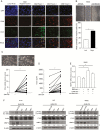CCL5 of glioma-associated microglia/macrophages regulates glioma migration and invasion via calcium-dependent matrix metalloproteinase 2
- PMID: 31593589
- PMCID: PMC7032635
- DOI: 10.1093/neuonc/noz189
CCL5 of glioma-associated microglia/macrophages regulates glioma migration and invasion via calcium-dependent matrix metalloproteinase 2
Abstract
Background: Glioma-associated microglia/macrophages (GAMs) comprise macrophages of peripheral origin and brain-intrinsic microglia, which support tumor progression. Chemokine C-C ligand 5 (CCL5) is an inflammatory mediator produced by immune cells and is involved in tumor growth and migration in several cancers, including glioma. However, the mechanisms detailing how CCL5 facilitates glioma invasion remain largely unresolved.
Methods: Glioma migration and invasion were determined by wound healing, transwell assay, and 3D µ-slide chemotaxis assay. The expression levels of CCL5, CD68, matrix metalloproteinase 2 (MMP2), phosphorylated Ca2+/calmodulin-dependent protein kinase II (p-CaMKII), p-Akt, and phosphorylated proline-rich tyrosine kinase 2 were determined by cytokine array, quantitative PCR, western blot, or immunohistochemistry. Zymography and intracellular calcium assays were used to analyze MMP2 activity and intracellular calcium levels, respectively.
Results: CCL5 modulated the migratory and invasive activities of human glioma cells in association with MMP2 expression. In response to CCL5, glioma cells underwent a synchronized increase in intracellular calcium levels and p-CaMKII and p-Akt expression levels. CCL5-directed glioma invasion and increases in MMP2 were suppressed after inhibition of p-CaMKII. Glioma cells tended to migrate toward GAM-conditioned media activated by granulocyte-macrophage colony-stimulating factor (GM-CSF) in which CCL5 was abundant. This homing effect was associated with MMP2 upregulation, and could be ameliorated either by controlling intracellular and extracellular calcium levels or by CCL5 antagonism. Clinical results also revealed the associations between CCL5 and GAM activation.
Conclusion: Our results suggest that modulation of glioma CaMKII may restrict the effect of CCL5 on glioma invasion and could be a potential therapeutic target for alleviating glioma growth.
Keywords: CCL5; MMP2; glioma; invasion; microglia.
© The Author(s) 2019. Published by Oxford University Press on behalf of the Society for Neuro-Oncology. All rights reserved. For permissions, please e-mail: journals.permissions@oup.com.
Figures






References
-
- Hsieh WT, Yeh WL, Cheng RY, et al. . Exogenous endothelin-1 induces cell migration and matrix metalloproteinase expression in U251 human glioblastoma multiforme. J Neurooncol. 2014;118(2):257–269. - PubMed
-
- Osswald M, Jung E, Sahm F, et al. . Brain tumour cells interconnect to a functional and resistant network. Nature. 2015;528(7580):93–98. - PubMed
Publication types
MeSH terms
Substances
LinkOut - more resources
Full Text Sources
Medical
Miscellaneous

